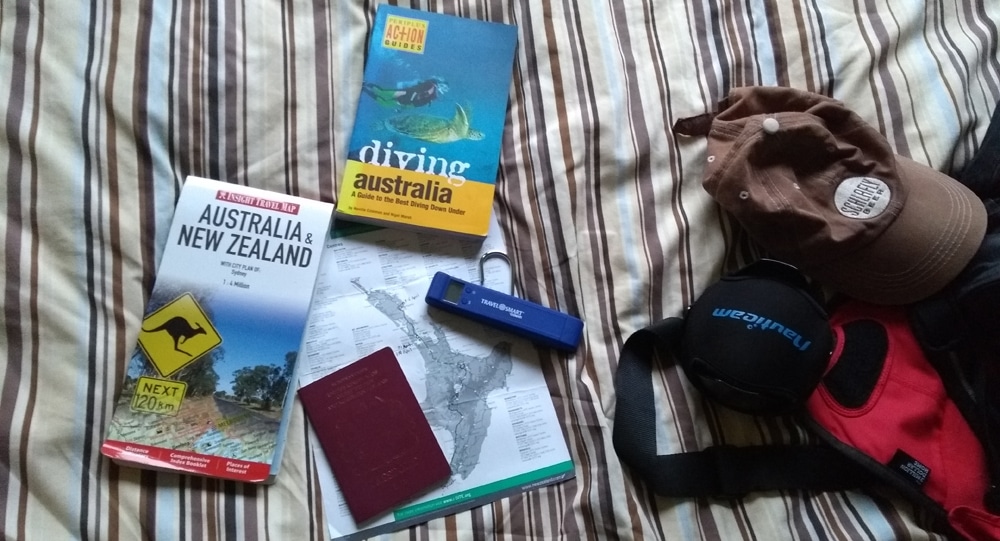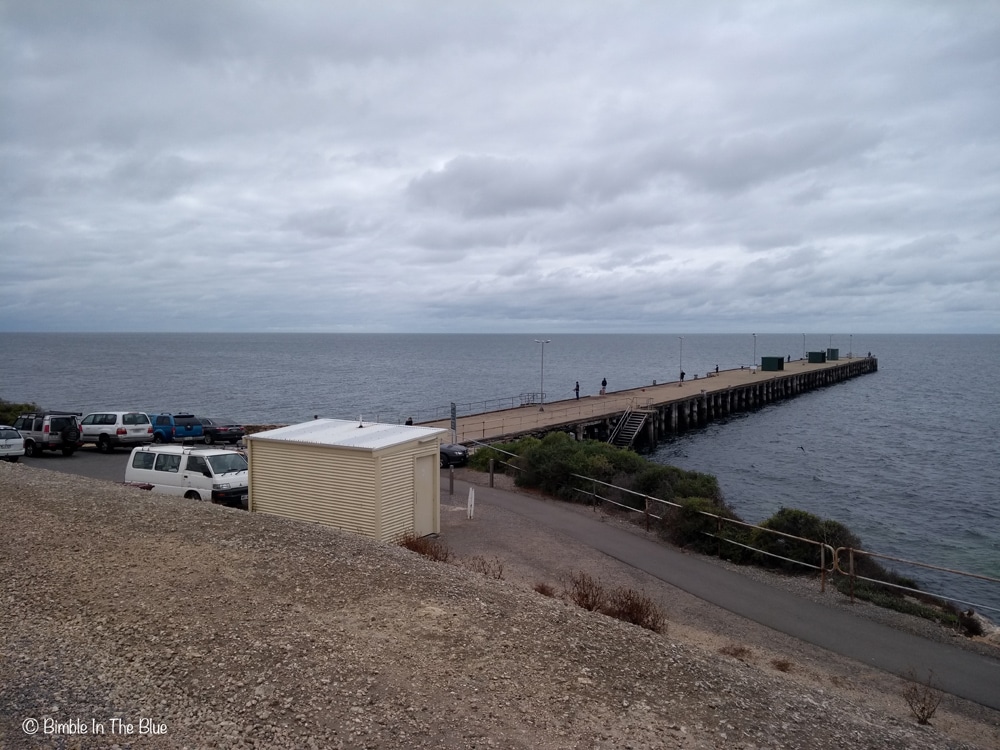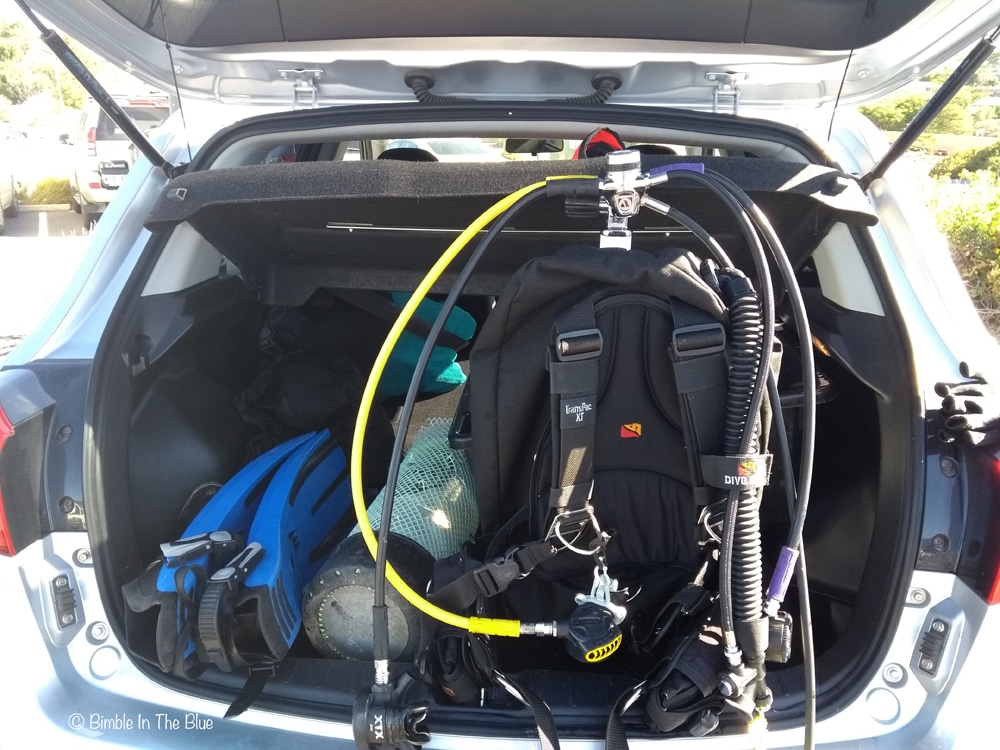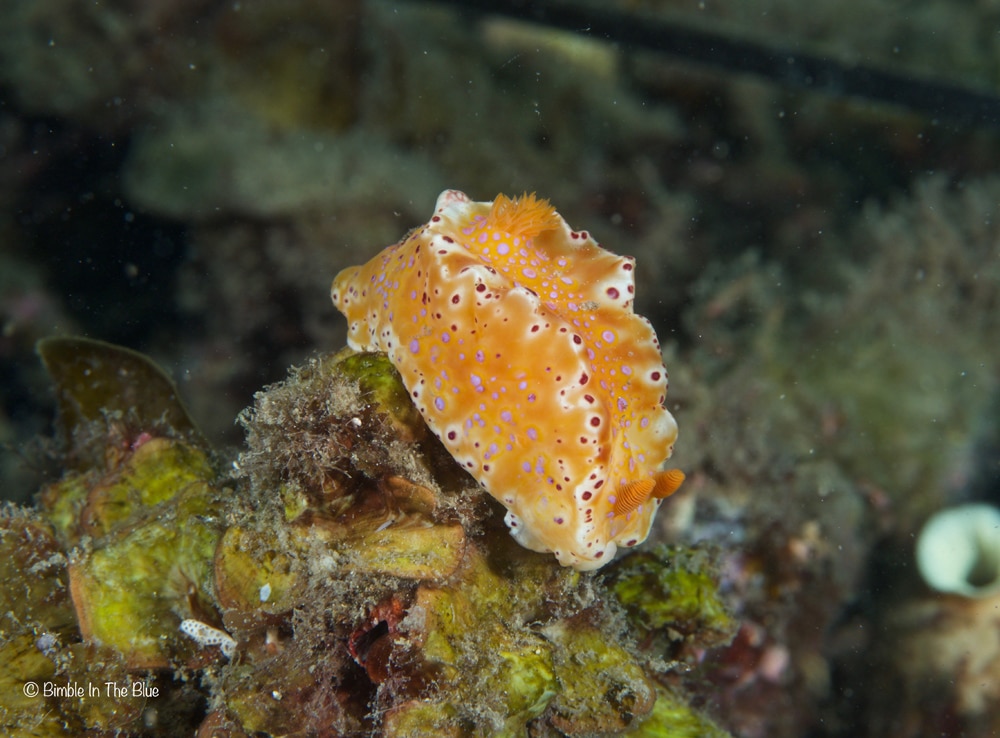News
Shore diving in South Australia: Part 1 – Edithburgh Jetty

The first in a three part series from Scubaverse regular bloggers CJ and Mike as they dive South Australia…
Mike and I got the travel bug again back in February and went off on another adventure! This time we planned to leave the grey skies of Manchester behind and fly to the warmth of Australia, for a week’s diving in Adelaide to try and spot some Leafy Sea Dragons. So it was off to Australia! Singapore Airlines was lovely, staff provided lots of water, the food was tasty and the seats were comfortable, but no seat will stop a very numb bum after 21hrs of flying. Arriving in Brisbane we found it really quite warm after the UK winter, (in Australia they have sunshine and blue skies, don’t you know!).
Since our destination was Adelaide, we boarded another flight having let our backsides recover somewhat and picked up out trusty rental car. We headed to chat with the friendly and helpful staff at Diving Adelaide, who we had been in email correspondence with prior to our trip. On arrival we were told weather was looking bad for two days and Rapid Bay Jetty, (our main aim) was going to be blown out that day, but Edithburgh Jetty might prove to be more diveable the next day, as it’s protected from south westerlies. Given the forecast we took a rest day (jet lag was making itself known at the point) and planned to go and check out Edithburgh the next day. You just can’t beat local knowledge!
One of the things we were most excited about on this trip was that it was that the dive sites are all shore dives. As great as boat diving is, I do love being able to show up somewhere with my buddy and just jump in. Particularly, when you can jump into waters so rich in marine life in just a few metres.
Dive 1: Edithburgh Jetty
After a much needed rest, the following day the weather was nice and cool (thank goodness, as we were in drysuits) and it seemed like it’d be worth risking the 3 hour drive and hoping the conditions are ok. Since we’d been up since 3:30am (Yay, jet-lag!) we made an early start and headed out about 6am for Edithburgh on the Yorke Peninsula, very much hoping to get a nice first dive of the trip in.
The drive went well and we saw lots of interesting local birds and lots of Aussie roadworks before arriving in Edithburgh. Turning left at the stop sign in town we came to the jetty and see divers in the car park kitting up. Result: It’s good to dive! Kitting up took a while as it was our first dive of the trip, but the time was well spent and we enjoyed a fabulous 70 min dive under Edithburgh Jetty, at a max depth of 5.3m. We saw a HUGE numbers of fish and invertebrate species we had never seen before and had a great, relaxed dive exploring, with Mike snapping away happily.
Edithburg Jetty dive details:
- Dive level: Easy
- Depth: 8m
- Type: Shore dive – Jetty, Photography, Night.
- Vis: 10m+
- Marine Life: Invertebrates, macro, squid, leafy seadragons.
- Entry: Steps
- Water temp: 18-21 degrees C (65-70F)
- Facilities: Yes, toilets, fresh water, car park, nearby food & drink, air fills at gas station.
Edithburgh Jetty is an easy dive, with good entry, shallow depth and is protected from the prevailing weather most of the year, making it very popular. It boasts a large amount of marine life including the striped pyjama squid, often seen on night dives and is highly rated for underwater photography.
The jetty begins at the end of Edith street and points east. It is 170m long and 11m at its widest point. The seabed is white sand littered with discarded structure which are covered with sponges and other invertebrate life, venturing out from under the jetty you will find seagrass and other marine plants in the surrounding area. The piles support a huge array of colourful marine life, it is very important to watch your buoyancy and fins so you do not damage the marine life on the seafloor and on the pilings.
The entry point is the steps 30m from the start of the pier, at about 2m at high tide, there is a handrail and the steps are close together making exiting the water comfortable. The maximum depth is 8m on the north side of the jetty where boats used to moor, but most of the dive is around 5m, so a good long dive exploring the whole structure is possible. Slow is best on this dive, air allowing, as it is shallow and you will likely see more critters if you take your time.
Visibility is often good (10m+) allowing you to see the jetty structure on both sides and navigate easily, however the vis can drop below 5m when easterly winds blow through. Possible dive plans include a simple out and back swim of about 350m, a swim to the end of the jetty and exploration of the deeper dredged area (8m), which is popular for squid spotting on night dives or a swim of around 550m, from the jetty to the tidal pool and back along the coast. When diving the jetty be aware of fishermen, it is best to stay fairly close to or underneath the pier. The tidal flow crosses the jetty and so be aware of the direction of water flow as it may cause more collisions with the pier structure.
The facilities here are good. There is car parking beside the jetty and car parks on either side of Edith street overlooking the jetty. There is also a small toilet block with a fresh water tap and nearby changing facilities at Edithburgh Tidal Pool. Food and drinks are available at the stores on Edith street and neighbouring streets and the BP petrol station offers air fills for AUD$10 per tank.
Next up… Rapid Bay Jetty.
Blogs
Northern Red Sea Reefs and Wrecks Trip Report, Part 3: The Mighty Thistlegorm

Jake Davies boards Ghazala Explorer for an unforgettable Red Sea diving experience…
Overnight, the wind picked up, making the planned morning dive a bit bumpy on the Zodiacs to the drop point on Thomas Reef. There, we would dive along the reef before descending through the canyon and then passing under the arch before ascending the wall with a gentle drift. The site provided great encounters with more pelagic species, including shoals of large barracuda, tuna, and bigeye trevally.
Once back on the boat, it was time to get everything tied down again as we would head back south. This time, with the wind behind us, heading to Ras Mohammed to dive Jackfish Alley for another great gentle drift wall dive before then heading up the coast towards the Gulf of Suez to moor up at the wreck of the Thistlegorm. This being the highlight wreck dive of the trip and for many onboard, including myself, it was the first time diving this iconic wreck. I had heard so much about the wreck from friends, and globally, this is a must on any diver’s list. Fortunately for us, there was only one other boat at the site, which was a rarity. A great briefing was delivered by Ahmed, who provided a detailed background about the wreck’s history along with all the required safety information as the currents and visibility at the site can be variable.

Kitting up, there was a lot of excitement on deck before entering the water and heading down the shoreline. Descending to the wreck, there was a light northerly current which reduced the visibility, making it feel more like the conditions that can be found off the Welsh coast. At 10m from the bottom, the outline of the wreck appeared as we reached the area of the wreck which had been bombed, as our mooring line was attached to part of the propeller shaft. Arriving on deck, instantly everywhere you looked there were many of the supplies which the ship was carrying, including Bren Carrier tanks and projectiles that instantly stood out.

We headed around the exterior, taking a look at the large propeller and guns mounted on deck before entering the wreck on the port side to take a look in the holds. It was incredible to see all the trucks, Norton 16H, and BSA motorcycles still perfectly stacked within, providing a real snapshot in time.

Overall, we had four dives on the Thistlegorm, where for all of the dives we were the only group in the water, and at times, there were just three of us on the whole wreck, which made it even more special, especially knowing that most days the wreck has hundreds of divers. Along with the history of the wreck, there was plenty of marine life on the wreck and around, from big green turtles to batfish, along with shoals of mackerel being hunted by trevally. Some unforgettable dives.

The final leg of the trip saw us cross back over the Suez Canal to the Gobal Islands where we planned to stay the night and do three dives at the Dolphin House for the potential of sharing the dive with dolphins. The site, which included a channel that was teeming with reef fish, especially large numbers of goatfish that swam in large shoals along the edge of the reef. These were nice relaxing dives to end the week. Unfortunately, the dolphins didn’t show up, which was okay as like all marine life they are difficult to predict and you can’t guarantee what’s going to be seen. With the last dive complete, we headed back to port for the final night where it was time to clean all the kit and pack before the departure flight the next day.

The whole week from start to finish on Ghazala Explorer was amazing; the boat had all the facilities you need for a comfortable week aboard. The crew were always there to help throughout the day and the chefs providing top quality food which was required after every dive. The itinerary providing some of the best diving with a nice mixture of wreck and reef dives. I would recommend the trip to anyone, whether it’s your first Red Sea liveaboard in the Red Sea or you’re revisiting. Hopefully, it’s not too long before I head back to explore more of the Red Sea onboard Ghazala Explorer.

To find out more about the Northern Red Sea reef and wrecks itineraries aboard Ghazala Explorer, or to book, contact Scuba Travel now:
Email: dive@scubatravel.com
Tel: +44 (0)1483 411590
Photos: Jake Davies / Avalon.Red
Blogs
Northern Red Sea Reefs and Wrecks Trip Report, Part 2: Wall to Wall Wrecks

Jake Davies boards Ghazala Explorer for an unforgettable Red Sea diving experience…
The second day’s diving was a day full of wreck diving at Abu Nuhas, which included the Chrisoula K, Carnatic, and Ghiannis D. The first dive of the day was onto the Chrisoula K, also known as the wreck of tiles. The 98m vessel remains largely intact where she was loaded with tiles which can be seen throughout the hold. The stern sits at 26m and the bow just below the surface. One of the highlights of the wreck is heading inside and seeing the workroom where the machinery used for cutting the tiles are perfectly intact. The bow provided some relaxing scenery as the bright sunlight highlighted the colours of the soft coral reef and the many reef fish.

Following breakfast, we then headed to the next wreck, which was the Carnatic. The Carnatic is an 89.9m sail steamer vessel that was built in Britain back in 1862. She ran aground on the reef back in 1869 and remains at 27m. At the time, she was carrying a range of items, including 40,000 sterling in gold. An impressive wreck where much of the superstructure remains, and the two large masts lay on the seafloor. The wooden ribs of the hull provide structures for lots of soft corals, and into the stern section, the light beams through, bouncing off the large shoals of glass fish that can be found using the structure as shelter from the larger predators that are found outside of the wreck.

The final wreck at Abu Nuhas was the Ghiannis D, originally called ‘Shoyo Maru,’ which was 99.5m long and built in Japan back in 1969 before becoming a Greek-registered cargo ship in 1980. The ship then ran aground on the reef on April 19th, 1983, and now sits at the bottom at a depth of 27m. Heading down the line, the stern of the ship remains in good condition compared to the rest of the hull. The highlight of the wreck, though, is heading into the stern section and down the flights of stairs to enter the engine room, which remains in good condition and is definitely worth exploring. After exploring the interior section of the ship, we then headed over to see the rest of the superstructure, where it’s particularly interesting to see the large table corals that have grown at the bow relatively quickly considering the date the ship sank. After surfacing and enjoying some afternoon snacks, we made sure everything was strapped down and secured as we would be heading north and crossing the Gulf of Suez, where the winds were still creating plenty of chop.

The next morning, it was a short hop to Ras Mohammed Nature Reserve for the next couple of days of diving. The 6am wake-up call came along with the briefing for the first site we would be diving, which was Shark & Yolanda. The low current conditions allowed us to start the dive at Anemone City, where we would drift along the steep, coral-filled wall. These dives involved drifts, as mooring in Ras Mohammed wasn’t allowed to protect the reefs. As a dive site, Shark & Yolanda is well-known and historically had a lot of sharks, but unfortunately not so many in recent years, especially not so early in the season. However, there was always a chance when looking out into the blue.

The gentle drift took us along the steep walls of the site, with plenty of anemone fish to be seen and a huge variety of corals. It wasn’t long into the dive before we were accompanied by a hawksbill turtle, who drifted with us between the two atolls before parting ways. Between the two reefs, the shallow patch with parts of coral heads surrounded by sand provided the chance to see a few blue-spotted stingrays that were mainly resting underneath the corals and are always a pleasure to see. With this being the morning dive, the early sunlight lit up the walls, providing tranquil moments. Looking out into the blue, there was very little to be seen, but a small shoal of batfish shimmering underneath the sunlight was a moment to capture as we watched them swim by as they watched us.

Towards the end of the dive, we stopped at the wreck of the Jolanda where the seafloor was scattered with toilets from the containers it was carrying. This provided a unique site to make a safety stop, which was also accompanied by a large barracuda slowly swimming by, along with a hawksbill turtle calmly swimming over the reef as the sun rays danced in the distance.
For the next dive, we headed north to the Strait of Tiran to explore the reefs situated between Tiran Island and Sharm El Sheik, which were named after the British divers who had found them. We started on Jackson before heading to Gordons Reef, where we also did the night dive. All the atolls at these sites provided stunning, bustling coral reefs close to the surface and steep walls to swim along, which always provided the opportunity to keep an eye out for some of the larger species that can be seen in the blue. Midwater around Jackson Reef was filled with red-toothed triggerfish and shoals of banner fish, which at times were so dense that you couldn’t see into the blue. Moments went by peacefully as we enjoyed the slow drift above the reef, watching these shoals swim around under the mid-afternoon sun.

The night dive at Gordon’s Reef was mainly among the stacks of corals surrounded by sand, which was great to explore under the darkness. After some time circling the corals, we came across what we were really hoping to find, and that was an octopus hunting on the reef. We spent the majority of the dive just watching it crawl among the reef, blending into its changing surroundings through changes in colour and skin texture. It’s always so fascinating and captivating to watch these incredibly intelligent animals, in awe of their ability to carry out these physical changes to perfectly blend into the reef. Before we knew it, it was time to head back to the boat to enjoy a well-deserved tasty dinner prepared by the talented chefs onboard.
Check in for the 3rd and final part of this series from Jake tomorrow!
To find out more about the Northern Red Sea reef and wrecks itineraries aboard Ghazala Explorer, or to book, contact Scuba Travel now:
Email: dive@scubatravel.com
Tel: +44 (0)1483 411590
Photos: Jake Davies / Avalon.Red
-

 News3 months ago
News3 months agoHone your underwater photography skills with Alphamarine Photography at Red Sea Diving Safari in March
-

 News3 months ago
News3 months agoCapturing Critters in Lembeh Underwater Photography Workshop 2024: Event Roundup
-

 Marine Life & Conservation Blogs2 months ago
Marine Life & Conservation Blogs2 months agoCreature Feature: Swell Sharks
-

 Blogs2 months ago
Blogs2 months agoMurex Resorts: Passport to Paradise!
-

 Blogs2 months ago
Blogs2 months agoDiver Discovering Whale Skeletons Beneath Ice Judged World’s Best Underwater Photograph
-

 Gear Reviews3 months ago
Gear Reviews3 months agoGear Review: Oceanic+ Dive Housing for iPhone
-

 Marine Life & Conservation2 months ago
Marine Life & Conservation2 months agoSave the Manatee Club launches brand new webcams at Silver Springs State Park, Florida
-

 News3 months ago
News3 months agoWorld’s Best Underwater Photographers Unveil Breathtaking Images at World Shootout 2023



















